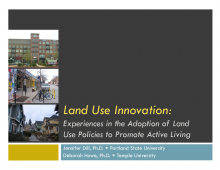We are pleased to announce an exciting new alliance between Active Living Research and GP RED to co-host and coordinate...
Land Use Innovation: Experiences in the Adoption of Land Use Policies to Promote Active Living

Presentation at the 2010 Active Living Research Annual Conference
Background:
The built environment is an important factor in encouraging people of all ages to be physically active on a daily basis whether for recreation or carrying out the tasks of everyday life. This includes such elements as well-maintained sidewalks and bike routes, safe means to cross busy roads, accessible and well-designed jogging paths, convenient and dependable public transit, and walking distance between homes, workplaces, schools and other common destinations, etc. The built environment is a result of the on-going dynamics of land development that involves builders, investors, consumers and public policies. It is through public policies that a broader public interest is articulated to achieve goals that may not be realized otherwise. Zoning is perhaps the most well known of implementation options for public policy on land use and development. Others include subdivision regulations, road access permitting, impact fees and public investments in transportation.
There are many exciting and inspiring initiatives throughout the US that complement efforts to create active living environments. These examples are regularly showcased at conferences aimed at practitioners and policy makers. And yet the entrenchment of the status quo throughout the US suggests that these reform efforts have a long way to go. Given the accessible examples of innovative approaches to land development reform, it stands to reason that a better understanding of the process of the acceptance and implementation of innovation at the local level is needed.
Objectives:
This research project sought to develop a multi-faceted study of a wide range of US communities and their experiences in adopting and implementing innovative land use policies and implementation tools that support active living (AL-oriented development policies). The essential aim is to develop an understanding of how to promote reformation of standard US land development policies to transform communities into environments that support active living. Specific questions that this presentation will address include the following:
• To what extent do these policies explicitly speak to and/or were motivated by active living and health goals?
• What are the essential factors in the dynamics of local adoption of AL-oriented development policies? Essential factors will be both exogenous (e.g. the regional economy) and endogenous (e.g. knowledge of local planners, funding availability, etc.).
• To what extent and under what circumstances does innovation acceptance lead to additional innovation?
• What barriers affect the use of AL-oriented development policies under existing regulatory, economic and lending standards?
Methods:
Three primary methods were used in this study:
1) An in-depth survey of 55 planners from best practices communities - cities or counties that had adopted mixed-use zoning and had model projects completed;
2) A random survey of planners from mid-sized cities (25,000-200,000) (n=146) and of planning directors who are members of the American Planning Association (n=222); and
3) Case studies of four cities with a range of experience in adopting innovative AL-policies (Woodstock, GA, Hickory, NC, Issaquah, WA, and Columbia, MO).
Results:
The surveys and case studies examined the impetus for innovation, sources of information, and the basis of support and opposition. The random survey revealed that mixed-use zoning was the most common innovative AL-oriented policy; it was included in the zoning code for over 80% of the respondents. However, only 10% of the respondents said that there was “a lot” of mixed use development activity in the past five years.
Health and enabling physical activity is a secondary, though growing, motivation for adopting AL-oriented development policies. The primary motivations included a desire to avoid bad development, livability, economic development, conserving natural resources, community revitalization, and creating dynamic centers. Increasing physical activity was an important factor for about 30% of the communities. The main impetus for innovation is usually internal to the community; state and regional plans and policies have little influence. The key players in adoption of innovative policies include local elected officials, the planning director, staff planners, and the planning commission. Public health agencies played almost no role in the adoption of mixed-use zoning in the best practices communities.
Respondents in the random survey indicated that the main reasons for not adopting innovative policies included a lack of planning staff time, opposition from residents, opposition from the business community, and lack of leadership from elected officials. Dominant concerns included density, parking, scale, development costs and traffic. Resources that are particularly useful in policy adoption included policies/language from other jurisdictions, model policies, field visits, consultants, web sites, and professional development events, conferences, and networks.
Conclusions:
The insights from this study will be helpful in enabling other communities to be more innovative. The study identified both barriers and opportunities that could be addressed by different organizations, including government and organizations such as the RWJF Active Living program. The presentation will include specific suggestions.
Support:
This research was funded by a grant from the Robert Wood Johnson Foundation’s Active Living Research Program.
Related Tools & Resources
STAY UP TO DATE
RECENTLY ADDED TOOLS & RESOURCES
MOVE! A BLOG ABOUT ACTIVE LIVING
The "Active Living Conference" aims to break down research and practice silos and...







